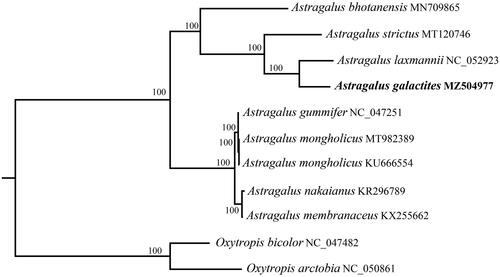Abstract
Astragalus galactites is a medicinal plant. The total plastome length of A. galactites is 126,117 bp. It contains a large single-copy region of 69,805 bp, two inverted repeat regions of 20,638 bp, and a small single-copy region of 15,036 bp. The cp genome contains 110 complete genes, including 75 protein-coding genes (75 PCGs), 4 ribosomal RNA genes (4 rRNAs), and 30 tRNA genes (30 tRNAs). The overall GC content of cp DNA is 33.9%, the corresponding values of the LSC, SSC, and IR regions are 33.0%, 30.4%, and 43.3% respectively. The phylogenetic tree shows that A. galactites has the closest relationship with A. laxmannii.
Astragalus galactites Pall. (Ledebour Citation1842), a desert psammophyte belongs to the family Fabaceae. It distributes in the northern part of China, Mongolia, and Siberia. The root can be used as a traditional Chinese medicine to consolidate the exterior and induce diuresis to reduce edema. (Zhong et al. Citation2012; Yang et al. Citation2010). This fact is being increasingly substantiated by pharmacological studies showing that it can increase telomerase activity and has antioxidant and diuretic effects (Anon Citation2003; Zhao et al. Citation2011). Meanwhile, a systematic study of this species would have significant implications for understanding the origin and evolution of the genus Astragalus and local flora. However, the chloroplast genome of A. galactites has not been reported. In this study, the complete chloroplast genome of A. galactites has been assembled in order to lay a foundation for further research.
Fresh leaves of A. galactites were collected from Tongxin (Wuzhong, Ningxia, China; coordinates: 106.4904E, 37.1414 N) and dried with silica gel. The DNA and voucher specimen was stored in the Herbarium of North Minzu University (NMU) with the number is zlnmu2021002 (Lei Zhang: [email protected]; Yuqing Wei: [email protected]). The total genomic DNA was extracted with the modified CTAB method (Doyle and Doyle Citation1987) and a 350-bp library was constructed. This library was sequenced on the Illumina NovaSeq 6000 system with 150 bp paired-end reads. We obtained 10 million high-quality pair-end reads for A. galactites. After removing the adapters, the remaining reads were used to assemble the complete chloroplast genome by GetOrganelle pipeline v1.6.3a (Jin et al. Citation2020). The complete chloroplasts genome sequence of A. gummifer was used as a reference. Plann v1.1 (Huang and CronK Citation2015) and Geneious v11.0.3 (Kearse et al. Citation2012) were used to annotate the chloroplasts genome and correct the annotation.
The total plastome length of A. galactites (MZ504977) is 126,117 bp. It exhibits a typical quadripartite structural organization, consisting of a large single copy (LSC) region of 69,805 bp, two inverted repeats (IR) regions of 20,638 bp, and a small single copy (SSC) region of 15,036 bp. The cp genome contains 110 complete genes, including 75 protein-coding genes (75 PCGs), 4 ribosomal RNA genes (4 rRNAs), and 30 tRNA genes (30 tRNAs). The overall GC content of cp DNA is 33.9%. The corresponding values of the LSC, SSC, and IR regions are 33.0%, 30.4%, and 43.3%.
To further clarify the phylogenetic position of Astragalus galactites, the plastome of 10 representatives Astragalus species were obtained from NCBI to reconstruct the plastome phylogeny, with Oxytropis bicolor and O. arctobia being an outgroup. All the sequences were aligned by using MAFFT v.7.313 (Katoh and Standley Citation2013) and the maximum likelihood of phylogenetic analyses was conducted through RAxML v.8.2.11 (Stamatakis Citation2014) under the GTRCAT model with 1000 bootstrap replicates. The phylogenetic tree shows that all Astragalus pecies were divided into two subclades (). A. galactites has the closest relationship with A. laxmannii.
Figure 1. Phylogenetic relationships of Astragalus pecies using whole chloroplast genome. GenBank accession numbers: Astragalus bhotanensis (MN709865), Astragalus strictus (MT120746), Astragalus laxmannii (NC_052923), Astragalus galactites (MZ504977), Astragalus gummifer (NC_047251), Astragalus mongholicus (MT982389), Astragalus mongholicus (KU666554), Astragalus nakaianus (KR296789), Astragalus membranaceus (KX255662), Oxytropis bicolor (NC_047482), Oxytropis arctobia (NC_050861).

Disclosure statement
No potential conflict of interest was reported by the author(s).
Data availability statement
The data that support the findings of this study are openly available in GenBank of NCBI at https://www.ncbi.nlm.nih.gov, reference number MZ504977. The associated BioProject, SRA, and Bio-Sample numbers are PRJNA746116 SRA: SRS2859862 and SAMN20181703, respectively.
Additional information
Funding
References
- Anon. 2003. Astragalusmembranaceus. Monograph. Altern Med Rev. 8:72–77.
- Doyle JJ, Doyle JL. 1987. A rapid DNA isolation procedure for small quantities of fresh leaf tissue. Phytochem Bull. 19:11–15.
- Huang D, Cronk Q. 2015. Plann: a command-line application for anno-tating plastome sequences. Appl Plant Sci. 3(8):1500026.
- Jin JJ, Yu WB, Yang JB, Song Y, dePamphilis CW, Yi TS, Li DZ. 2020. GetOrganelle: a fast and versatile toolkit for accurate de novo assembly of organelle genomes. Genome Biol. 21(1):241.
- Katoh K, Standley D. 2013. MAFFT multiple sequence alignment software Version 7: improvements in performance and usability. Mol Biol Evol. 30(4):772–780.
- Kearse M, Moir R, Wilson A, Stones-Havas S, Cheung M, Sturrock S, Buxton S, Cooper A, Markowitz S, Duran C, et al. 2012. Geneious basic: an integrated and extendable desktop software platform for the organization and analysis of sequence data. Bioinformatics. 28(12):1647–1649.
- Ledebour CF. 1842. Astragalus galactites Pallas Sp. Astragal. Flora Rossica. 1:656.
- Stamatakis A. 2014. RAxML version 8: a tool for phylogenetic analysis and post-analysis of large phylogenies. Bioinformatics. 30(9):1312–1313.
- Yang X, Huang S, Chen J, Song N, Wang L, Zhang Z, Deng G, Zheng H, Zhu XQ, Lu F. 2010. Evaluation of the adjuvant properties of Astragalus membranaceus and Scutellaria baicalensis GEORGI in the immune protection induced by UV-attenuated Toxoplasma gondii in mouse models. Vaccine. 28(3):737–743.
- Zhao LH, Ma ZX, Zhu J, Yu HX, Weng DP. 2011. Characterization of polysaccharide from Astragalus radix as the macrophage stimulator. Cell Immunol. 271(2):329–334.
- Zhong RZ, Yu M, Liu HW, Sun HX, Cao Y, Zhou DW. 2012. Effects of dietary Astragalus polysaccharide and Astragalus membranaceus root supplementation on growth performance, rumen fermentation, immune responses, and antioxidant status of lambs. Anim Feed Sci Technol. 174(1–2):60–67.
